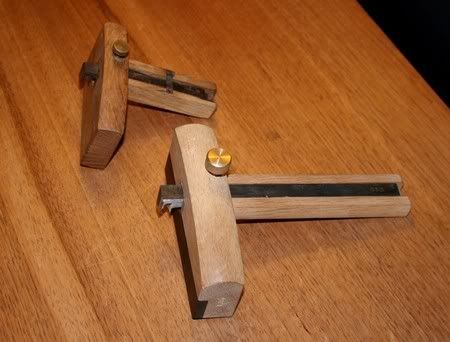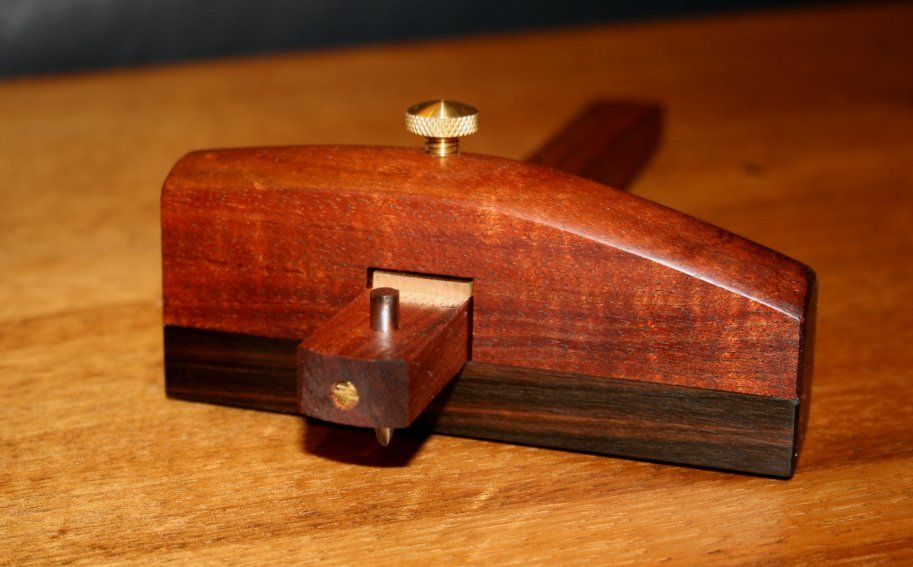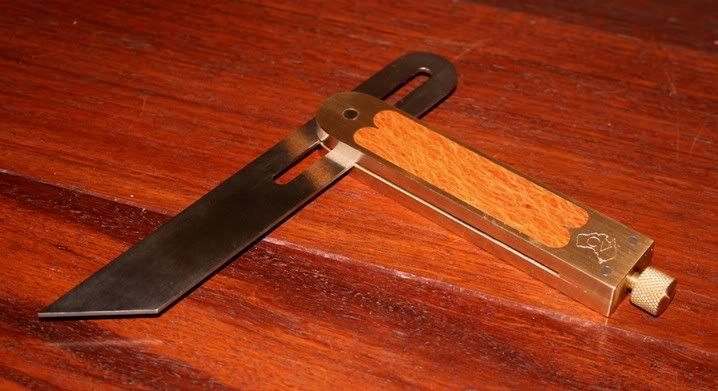 Thanks: 0
Thanks: 0
 Needs Pictures: 0
Needs Pictures: 0
 Picture(s) thanks: 0
Picture(s) thanks: 0
Results 1 to 15 of 42
Thread: measuring and setout tools
-
23rd September 2012, 09:53 AM #1
 measuring and setout tools
measuring and setout tools
Hi everyone
Partly inspired by JillB's questions about her out-of-alignment tri-square, I was wondering what people use for measuring and setting out. I scrape by with an eclectic collection of bits and pieces - steel rules, an old tri-square, normal tape measures, and some other junk, but I need to evolve to improve my accuracy. I've been contemplating some of the woodpecker rules and squares, but haven't pulled the trigger yet. I liked the Starrett double squares or combination squares too...
So, let's hear what you use, and why. Bonus points for pics...
TravSome days we are the flies; some days we are the windscreen
-
23rd September 2012 09:53 AM # ADSGoogle Adsense Advertisement
- Join Date
- Always
- Location
- Advertising world
- Age
- 2010
- Posts
- Many
-
23rd September 2012, 11:52 AM #2

I had been using a mixed set of M&M tools and I wanted a good quality square. I bought a Colen Clenton adjustable square earlier this year and I liked it so much I lashed out and bought two marking gauges and another square (45°) from Colen at the Sydney Wood Show.
I love using them and highly recommend any of Colen's tools. They not only look spectacular, IMO, but are very tactile. You just want to pick them up and play with them.
I will be adding more of Colen's gear as finances allow.
CC Tools.jpgLast edited by NCArcher; 23rd September 2012 at 12:13 PM. Reason: Added Pic
-
23rd September 2012, 04:01 PM #3
 GOLD MEMBER
GOLD MEMBER











- Join Date
- Mar 2009
- Location
- Sydney
- Age
- 37
- Posts
- 2,711

Gifkins dovetail sell a set of 4 squares for $79 which includes a 45 degree square also. I think this represents good value for money. You can buy them individually - $20 for the smaller one and $29 for the larger one.
Gifkins Dovetail Jig
I personally have a Starrett combination square which is one of my favourite tools. I used to own a Colen Clenton square like the one above and have since purchased a Chris Vesper 7" square.
Vesper squares - https://www.vespertools.com.au/index...mart&Itemid=34
I believe investing in good quality laying out tools is important, not only are they a joy to use but will give you accurate results.
Good luck,
Andy
-
24th September 2012, 12:18 PM #4

Trav - like you, I use a mix. The device depends very much on the job in hand, and in many cases in w'working, you don't even need anything with super-precise markings - repeatability & fit are what matters. When building pieces of solid wood furniture, accuracy is usually more important than precision, meaning it doesn't mattter if a board is 18mm or 19mm thick, as long as it fits neatly where it's wanted, or other parts meant to be fitted to it match. The size for part B is taken from its corresponding part A, either by marking directly, or transferred by calipers & marking gauges, etc. Many of my measuring devices are home-made, but I do like my Colen Clenton square, and the larger one I made based on the same principle. Being able to check & recalibrate a square regularly gives me confidence. I don't have much need for set angles other than 90, but if I made stuff that used a lot of 45 angles, I would probably make or acquire a decent trysquare for the purpose. However, for the little I do, an old medium-quality combination square does the job well enough. It can be useful in quite a few ways, in fact, for example, it makes a handy depth gauge, or a very stubby square when I need to mark a square line in a tight space.
This is a bit of a hobby-horse of mine; if you work with solid wood, measuring any part to fractions of a mm can be a waste of time. Tomorrow that could change by many mm, depending on the wood, the weather & size of part, so if you haven't already fitted it where it belongs, you may still need to trim or shim. It's usually safer to cut slightly oversize, trim, & fit (immediately, if possible). It's a different matter if you are making stuff from sheet-goods in a factory, where bits have to fit precisely day in and day out, and remain within tolerances for drawer slides & appliances, etc. Precision is both necessary and achievable under these conditions. But you should always be accurate in either scenario....
My 2c.IW
-
24th September 2012, 01:10 PM #5

I measure not with a rule but by transferring measurements with a cutting gauge. So I have a few ...

I have a Colen Clenton, which is very nicely made and beautiful to look at, but does require two hands to adjust.
My favourite is the Japanese Kinshiro, which doubles as a mortice cutter. I have a couple ..

... and made a few as well in single blade form ...


The wheeled type is also very handy and excel being used one-handed. Lee Valley have just brought out a stainless steel Anniversary model, and I snapped up a couple (cheap!!!). The one in the centre, flanked by the basic LV model and the micro-adjustable Tite-Mark ...

Don't even get me started on marking knives or squares (go to Chris Vesper's site!).
Regards from Perth
DerekVisit www.inthewoodshop.com for tutorials on constructing handtools, handtool reviews, and my trials and tribulations with furniture builds.
-
26th September 2012, 09:44 PM #6

It's almost a case of "you can't have too many layout tools"
I'm a bit like Andy
I love my Starret combination square -- I have 2 (12" and 6") -- and the laser cut triangles from Colin Clenton and Gifkins
I also love the Lee Valley small (4") double square
then like Derek I have an assembly -- I refuse to call it a collection -- of gauges by Colin Clenton, Chris Vesper and others
and a few CC squaresregards from Alberta, Canada
ian
-
26th September 2012, 09:56 PM #7

Until you run out of room in your tool cupboard.

I have several more markng gauges that I didn't show because I though 5 was a bit OTT, but after Derek's post, I realise I don't have a problem after all.
From this and the thread on squares, it's interesting to me that we all have some similarities and some (major) differences in the tools we prefer to use to get this job done. It's worse than sharpening, because there is even more choice of how you can go about it!
Cheers,IW
-
26th September 2012, 10:58 PM #8

5 marking gauges is nowhere near Over The Top.
My son is building a tool box at school -- setting out the rebate joints needs TWO gauges
A couple of years ago I built a table, installing the divider between the top and bottom rails required FOUR different gauge settings --> four gauges
It's not beyond my imagination that a project might require 10 gauges, each locked to a particular dimension for the duration of the build
-
26th September 2012, 11:49 PM #9
 GOLD MEMBER
GOLD MEMBER











- Join Date
- Mar 2008
- Location
- Townsville, Nth Qld
- Posts
- 4,236

I use a couple of 300mm long try squares that I check infrequently with my carefully guarded box of precision Engineers squares, kept specifically for this purpose. The Spears and Jackson try square has graduations on the edges of the blade which I find useful.
For measuring, I also use Toledo stainless steel rules, 150mm and 300mm long, and use these to mark out mortices and tenons with a 0.5mm PaperMate pencil lead. Would love to have some good setting out gauges, but they are so expensive.
For longer distances I use a tape, but never at the beginning of the tape - always start at the 100mm point - far more accurate than the loose edge at the beginning of the ruler. One of my favourites is the Toledo 1000mm long stainless steel rule - a great straight edge too.
For setting out on plywood panels, I use a carpenters framing square together a 6mm x 50mm wide aluminum angle straight edge clamped across the panel
The tool that I most use is my manual Mitsutoyo?? vernier caliper. Tried the M & W digital calipers for a few months, but returned to the manual ones - so much easier to use, no need to switch on, then reset to zero every time ( just to be sure), and easy to read upside down (I am a leftie), and I leave it clamped in a handy spot on a magnetic bar - no electronic components to disturb.regards,
Dengy
-
27th September 2012, 12:40 AM #10

How about measuring with this ruler.

Ps. I do own some CV, CC and LV stuff.
Les
festool_rule.jpg
-
27th September 2012, 06:46 AM #11
 well aged but not old
well aged but not old











- Join Date
- Sep 2004
- Location
- Brisbane
- Posts
- 925

I have an old Stanley square for smaller jobs and a big square I made out of Jarah for larger jobs. I also use an old Marples marking gauge. For measurement I have some steel rulers, digital calipers, a metal tape measure and an Incra T ruler with holes for a pencil every one billionth of a mm. I felt all was well with that until I read this thread. This lot gets me by okay but I have thought about getting a Veritas marking gauge sometime.
My age is still less than my number of posts
-
27th September 2012, 08:53 AM #12
-
27th September 2012, 09:31 AM #13
 measuring and setout tools
measuring and setout tools
Colen Clenton, Chris Vesper and home made tools are all terrific.
I have way too many of each but my favourites:
CC screw mortice cutting gauge; just a stunning bit of kit
CC cutting gauge; as above
CV cutting gauge; I have several as they work well
CV try squares; great design and that little tab stop is useful
CC mitre gauge;
CC awl;
CV joinery knives; )
)
DC marking knives; ;-)
I have long held the desire to make my own variations of the above. Maybe one day I'll get 'round to it.
-
27th September 2012, 06:30 PM #14

Lots of Chris Vespers there, Kev. A man od discerning taste!

I like my Colen Clenton 9" for many things, but that little 4" jobbie of Chris' is my go-to for all joinery.
(from his website)...

Chris' sliding bevel is the best around .

For layout I now have a large square I made (and posted here recently) ..


It got a mention on Chris Schwarz' blog: How to Use an English Layout Square
Regards from Perth
DerekVisit www.inthewoodshop.com for tutorials on constructing handtools, handtool reviews, and my trials and tribulations with furniture builds.
-
27th September 2012, 07:11 PM #15
 Senior Member
Senior Member











- Join Date
- Feb 2012
- Location
- Adelaide
- Posts
- 451
 is that important?It got a mention on Chris Schwarz' blog: How to Use an English Layout Square
is that important?It got a mention on Chris Schwarz' blog: How to Use an English Layout Square
he's just a writer and a blog dude, not qualified or such, not as a trade, or even particularly skilled (by his own words), his strengths lie as a writer perhaps and publicist and developing a celebrity status, i guess he gets a wide audience so maybe thats it...might have made more impact if you let someone else make the mention that our Derek got a line by the guru himself
 ...tell me first , then i can brag on your behalf
...tell me first , then i can brag on your behalf  but as your agent i might have other ideas
but as your agent i might have other ideas 
btw, i'm just curious, why do people all love the CC so much and in general brass squares when they never seem to actually use them, when ever i see a pic on the net by the guys that own them they always seem to be using the old, but reliable combination square!
Similar Threads
-
Oval Setout Tool
By Blocklayer in forum ANNOUNCEMENTSReplies: 0Last Post: 23rd December 2010, 12:55 PM -
chisel sharpening guide - setout for degree of bevel
By famreeks in forum SHARPENINGReplies: 2Last Post: 17th July 2009, 08:00 PM -
Measuring tape - not only for measuring
By niki in forum HOMEMADE TOOLS AND JIGS ETC.Replies: 14Last Post: 16th February 2007, 08:46 PM -
Measuring with a Jog Stick
By onthebeachalone in forum BOAT BUILDING / REPAIRINGReplies: 0Last Post: 9th October 2006, 03:14 PM



 Likes:
Likes: 
 Reply With Quote
Reply With Quote



